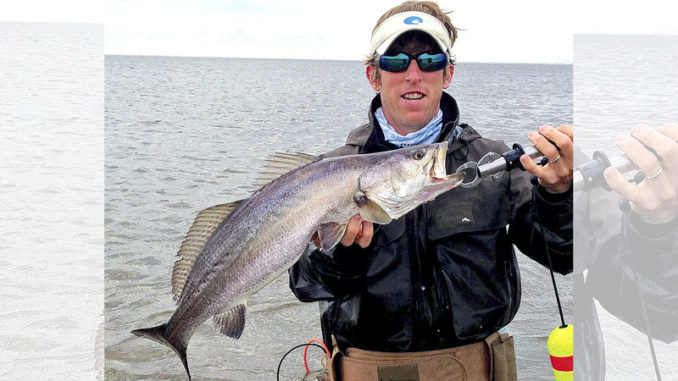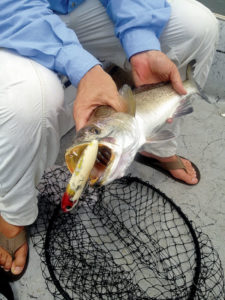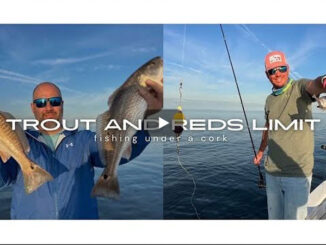
Speckled trout should be working strong; big fish make great showing in spring.
Drifting onto a flat at the north end of Sabine, I asked Ryan Pyburn, “Do you see anything?”
“Nope,” he said, “How about you?”
Unfortunately, my response was the same.
The water clarity was decent but had zero signs of life. We quickly decided to motor further south in search of greener pastures. Pelicans were diving, and mullet were jumping as we trolled into our next spot, a great sign for any angler in search of a trout bite. When I turned to let him know that I was hooked up, I noticed he had a fish on as well.
Pyburn was fishing a MirrOdine XXL with a black back and orange belly, while I was chunking a swimbait. The fish were hanging near the bottom in 4 feet of water, with no interest in our topwaters.
Pyburn is addicted to the bluewater, where he spends a lot of time aboard his Contender, but he is also a darn good trout fisherman. We pick each other’s brain on a regular basis and both agree that if you’re going to catch your biggest-ever trout, it is likely to be during March or April. As water temperatures gradually warm, trout begin to feed more frequently and get ready to start spawning. Research may vary slightly but supports spawning in water temperatures as low as 71 degrees up to as high as 93, with the majority taking place in the low-80s. That resulting in trout being the heaviest they will be during the early spring.

Trout locations, tactics
Fortunately for us, trout will be drawing much more attention to themselves, making them much easier to locate and catch. Slicks may as well be a white flag raised in surrender, as they are a tell-tale sign of feeding fish. If you aren’t into the wading program, I’d highly recommend investing in a Power Pole if you don’t already have one, as well as a good drift sock. A manual anchor will work fine, just try to avoid heaving it like a sack of feed. One thing for sure is that the wind is going to blow, being able to stop or at least slow down your drift is essential.
We should also start seeing some signs of bird activity over feeding trout, and redfish hustling shrimp to the surface. On Sabine, this will start on the south end, west of Blue Buck Point and traveling north from there along the levees. On Big Lake, we will see them starting in West Cove and just east of the washout up to Long Point. A good pair of binoculars will help save you some fuel if you’re into the bird action.
Slow sinkers and suspending baits will still get the job done if you’re after the trophy trout bite, but you’ll find the likes of Pyburn choosing topwaters. In high wind conditions, I believe the noisier the better. A hi-frequency She Dog or a Heddon One Knocker should get the job done just fine. I highly recommend a monofilament leader in the 20- to 30-pound class if fishing braided line to allow for a little stretch for those quick runs to prevent pulling hooks. Make sure you’ve got a good knot tied, back off the drag a little and hang on.


